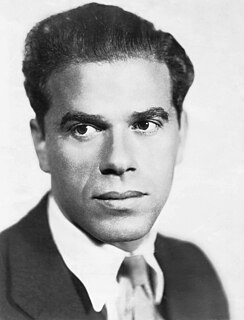
Frank Russell Capra was an Italian-born American film director, producer and writer who became the creative force behind some of the major award-winning films of the 1930s and 1940s. Born in Italy and raised in Los Angeles from the age of five, his rags-to-riches story has led film historians such as Ian Freer to consider him the "American Dream personified".

Barbara Stanwyck was an American actress, model and dancer. A stage, film, and television star, during her 60-year professional career she was known for her strong, realistic screen presence and versatility. She was a favorite of directors, including Cecil B. DeMille, Fritz Lang, and Frank Capra, and made 85 films in 38 years before turning to television.
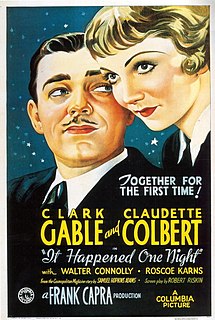
It Happened One Night is a 1934 pre-Code American romantic comedy film with elements of screwball comedy directed and co-produced by Frank Capra, in collaboration with Harry Cohn, in which a pampered socialite tries to get out from under her father's thumb and falls in love with a roguish reporter. The screenplay by Robert Riskin is based on the August 1933 short story "Night Bus" by Samuel Hopkins Adams, which provided the shooting title. Classified as a "pre-Code" production, the film is among the last romantic comedies created before the MPPDA began rigidly enforcing the 1930 Motion Picture Production Code in July 1934. It Happened One Night was released just four months prior to that enforcement.

It's a Wonderful Life is a 1946 American Christmas fantasy drama film produced and directed by Frank Capra, based on the short story and booklet The Greatest Gift, which Philip Van Doren Stern self-published in 1943 and is in turn loosely based on the 1843 Charles Dickens novella A Christmas Carol. The film stars James Stewart as George Bailey, a man who has given up his personal dreams, in order to help others in his community, and whose thoughts of suicide on Christmas Eve brings about the intervention of his guardian angel, Clarence Odbody.

Lady for a Day is a 1933 American pre-Code comedy-drama film directed by Frank Capra. The screenplay by Robert Riskin is based on the 1929 short story "Madame La Gimp" by Damon Runyon. It was the first film for which Capra received an Academy Award nomination for Best Director and the first Columbia Pictures release to be nominated for Best Picture. Capra also directed its 1961 remake, Pocketful of Miracles.

Mr. Deeds Goes to Town is a 1936 American comedy-drama romance film directed by Frank Capra and starring Gary Cooper and Jean Arthur in her first featured role. Based on the 1935 short story "Opera Hat" by Clarence Budington Kelland, which appeared in serial form in The American Magazine, the screenplay was written by Robert Riskin in his fifth collaboration with Frank Capra.

The Awful Truth is a 1937 American screwball comedy film directed by Leo McCarey and starring Irene Dunne and Cary Grant. Based on the 1923 play The Awful Truth by Arthur Richman, the film recounts how a distrustful rich couple begins divorce proceedings, only to interfere with one another's romances. This was McCarey's first film for Columbia Pictures with the dialogue and comic elements being largely improvised by the director and actors. It was Dunne's second comedy following Theodora Goes Wild (1936), for which she was also nominated for a Best Actress Academy Award. Her costumes were designed by Robert Kalloch. Although Grant tried to leave the production due to McCarey's directorial style, The Awful Truth saw his emergence as an A-list star and proponent of on-the-set improvisation.

Lost Horizon is a 1937 American adventure drama fantasy film directed by Frank Capra. The screenplay by Robert Riskin is based on the 1933 novel of the same name by James Hilton.
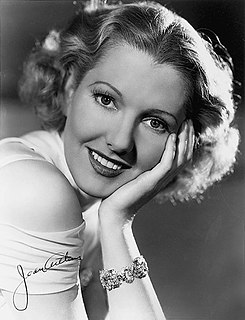
Jean Arthur was an American Broadway and film actress whose career began in silent films in the early 1920s and lasted until the early 1950s.
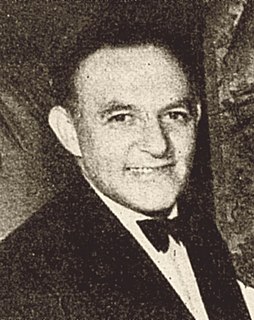
Harry Cohn was a co-founder, president, and production director of Columbia Pictures Corporation.
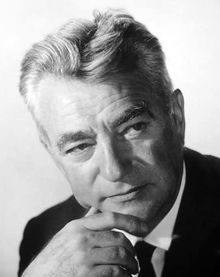
Charles Vidor was a Hungarian film director. Among his film successes are The Bridge (1929), The Tuttles of Tahiti (1942), The Desperadoes (1943), Cover Girl (1944), Together Again (1944), A Song to Remember (1945), Over 21 (1945), Gilda (1946), The Loves of Carmen (1948), Rhapsody (1954), Love Me or Leave Me (1955), The Swan (1956), The Joker Is Wild (1957), and A Farewell to Arms (1957).

Pocketful of Miracles is a 1961 American comedy film starring Bette Davis and Glenn Ford, produced and directed by Frank Capra, filmed in Panavision. The screenplay, by Hal Kanter and Harry Tugend, was based on Robert Riskin's screenplay for the 1933 film Lady for a Day, which was adapted from the 1929 Damon Runyon short story "Madame La Gimp." That original 1933 film was also directed by Capra — one of two films that he originally directed and later remade, the other being Broadway Bill (1934) and its remake Riding High (1950).

Walter Wanger was an American film producer active from the 1910s, his career concluding with the turbulent production of Cleopatra, his last film, in 1963. He began at Paramount Pictures in the 1920s and eventually worked at virtually every major studio as either a contract producer or an independent. He also served as President of the Academy of Motion Picture Arts and Sciences from 1939 to October 1941 and from December 1941 to 1945. Strongly influenced by European films, Wanger developed a reputation as an intellectual and a socially conscious movie executive who produced provocative message movies and glittering romantic melodramas. He achieved notoriety when, in 1951, he shot and wounded the agent of his then-wife, Joan Bennett, because he suspected they were having an affair. He was convicted of the crime and served a four-month sentence, then returned to making movies.

Robert Riskin was an American Academy Award-winning screenwriter and playwright, best known for his collaborations with director-producer Frank Capra.

State of the Union is a 1948 drama film directed by Frank Capra about a man’s desire to run for the nomination as the Republican candidate for President, and the machinations of those around him. The New York Times described it as "a slick piece of screen satire...sharper in its knife-edged slicing at the hides of pachyderm schemers and connivers than was the original." The film was written by Myles Connolly and Anthony Veiller and was based on the 1945 Russel Crouse, Howard Lindsay Pulitzer Prize-winning play of the same name.

The Bitter Tea of General Yen is a 1933 American pre-Code drama war film directed by Frank Capra and starring Barbara Stanwyck, and featuring Nils Asther and Walter Connolly. Based on the 1930 novel of the same name by Grace Zaring Stone, the film is about an American missionary in Shanghai during the Chinese Civil War who gets caught in a battle while trying to save a group of orphans. Knocked unconscious, she is saved by a Chinese general warlord who brings her to his palace. When the general falls in love with the naive young woman, she fights her attraction to the powerful general and resists his flirtation, yet remains at his side when his fortune turns.
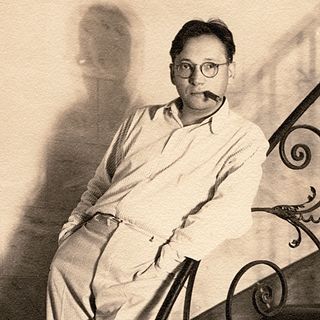
Jo Swerling was an American theatre writer, lyricist and screenwriter.

The Miracle Woman is a 1931 American pre-Code romance film directed by Frank Capra and starring Barbara Stanwyck, David Manners, and Sam Hardy. Based on the play Bless You Sister by John Meehan and Robert Riskin, the film is about a preacher's daughter who becomes disillusioned by the mistreatment of her dying father by his church. Having grown cynical about religion, she teams up with a con man and performs fake miracles for profit. The love and trust of a blind man, however, restores her faith in God and her fellow man. The Miracle Woman was the second of five film collaborations between Capra and Stanwyck. Produced and distributed by Columbia Pictures, the film was reportedly inspired by the life of Aimee Semple McPherson.

Barbara Stanwyck was a prolific American actress and dancer who appeared in a total of 95 theatrically released full-length motion pictures. Orphaned before she was old enough to attend school, she became fascinated by the burgeoning film industry, and actress Pearl White in particular, whom she would mimic on the playgrounds. "Pearl White was my goddess, and her courage, her grace and her triumphs lifted me out of this world."
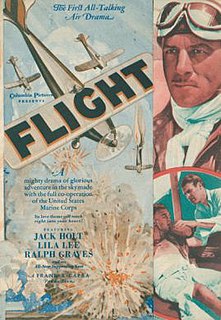
Flight is a 1929 adventure and aviation film directed by Frank Capra. The film stars Jack Holt, Lila Lee and Ralph Graves, who also came up with the story, for which Capra wrote the dialogue. Dedicated to the United States Marine Corps, the production was greatly aided by their full cooperation.




















